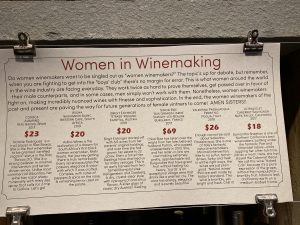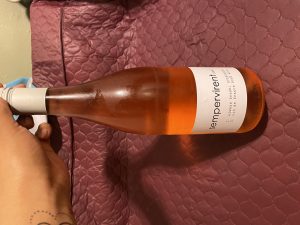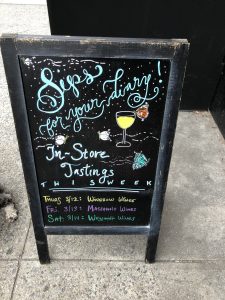Wine List Analysis
Yulisa Trejo Aquino
Prof. Karen Goodlad
HMGT2402-E553
March 25th, 2020
New York City College Of Technology
Wine lists can vary among different restaurants depending on the menu, type of restaurant and of course the area where the restaurant is located. Fine dining restaurants, for example, have a sommelier, also known as a wine steward. In this paper, I will be analyzing the wine list of casual dining and of a fine dining restaurant. This analysis will entail some compare and contrast characteristics of both wine lists, as well as some general observations that are important to mention. The restaurants I chose for this analysis are Carmine’s Italian restaurant and River Cafe. Carmine’s is a family-style Italian, casual restaurant established in 1990, and today has five different establishments within the United States. On the other hand, the fine dining restaurant, River Cafe was established in 1977, and as of today has received a Michelin star, Wine Spectator Award, among many other recognitions within the industry.
At Carmine’s, one observation I made is that the wine list is surprisingly short. The list of all beverages is compiled within just one page PDF file and the wine options are very limited. The restaurant offers two varieties of white wines, and four different red wines are all that is found within the wine category, in the drinks menu. In addition, the menu at Carmine’s does not contain any serving size nor price indicators, meaning there are no serving specifications as to the amount of wine one can get, whether it may be per glass, half a bottle or per bottle. In the red category of wine that Carmine’s offers, there are not many familiar names that I would immediately recognize. This observation spiked my interest in regards to the grape variety used for the wines listed. Among the grape variety that I have heard of before, wines offered at Carmine’s are chardonnay and sauvignon blanc, which also happens to be the only two white wines listed.
One the other hand, River Cafe has a very extensive list of wines. Personally, I have never been to a fine dining restaurant, and have not had the opportunity to be presented with a 19-page wine list. Therefore, at first sight, I was very overwhelmed with the amounts of different wines offered at River Cafe. It is one of the most detailed menus I’ve seen. The menu itself comprises the vintage of the wines displayed, along with the price per bottle, glass, and/or half bottle. The menu presents all the wines offered by the glass on the first page, along with the prices. Then, the menu proceeds to display fortified wines and sparkling wines. Furthermore, the menu is arranged by country and a subcategory of the regions within each country. This feature is more notable within the listed wines from France and Italy.
In addition, there are some similarities and differences between the two restaurants. Among the similarities, which are very few is that they note the designation of the wines on the menu. For example, at Carmine’s the choice of reds listed has the DOCG designation which means Denominazione di Origine Controllata e Garantita. This is to note the quality classifications the wines fall under as per Italian wine laws. DOCG in Italian wines is the highest designation of quality among wines produced in Italy. On the other hand, the differences between the two wine menus are more evident. At River Cafe, the wines are listed with the vintage, prices, and region, and in some cases (for Italian wines), the DOCG designation is also displayed, while at Carmine’s simply the name and designation are displayed with no further information. Another major difference is the variety and extensiveness of the menus. Carmine’s has a total of six wines listed, as per River Cafe has 19 pages of selected wines. Another major and notable difference is that River Cafe has a footnote on every page, that denotes the level of sweetness on specific wines wherever there is an indication of one to four asterisk (*).
In conclusion, there are some interesting differences and similarities between the two wine menus at Carmine’s, and River Cafe. Something new that I learned through my research is that NV (as listed on some of the Sparkling wines and Champagnes at River Cafe) means Non-Vintage. This sparked my interest because it was only on some wines, while the rest displayed the vintage. This means that the wine was produced from blending various years together. In comparison to the menu of Carmine’s, no wines were listed with a vintage. Another characteristic that surprised me was the price range of wines. At River Cafe, there were wines listed with a price of up to $7,800 dollars which I did not know a bottle of wine could cost so much. This was listed for La Tâche – Grand Cru – Domaine de la Romanée Conti 2009. Lastly, I assume that the food pairing for the wines at River Cafe are not listed in order to create almost an interactive experience for the customer, the wine list, and the sommelier once they visit the establishment.
CITATION
Wine Program – Long Term Cellaring – Connoisseurs – Brooklyn, New York. (n.d.). Retrieved
March 19th, 2020 from https://rivercafe.com/wine-program/
Private Dining Rooms NYC – Upper West Side: Carmine’s Italian Restaurant: Carmine’s. (n.d.).
Retrieved March 19th , 2020from https://www.carminesnyc.com/parties/upper-west-side
Wine Vintages and Why They Matter (Sometimes). (2016, September 9). Retrieved March 19th,
2020 from https://winefolly.com/deep-dive/wine-vintages-and-why-they-matter/










